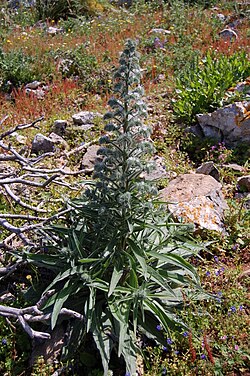| Italian viper's bugloss | |
|---|---|
 | |
| Scientific classification | |
| Kingdom: | Plantae |
| Clade: | Tracheophytes |
| Clade: | Angiosperms |
| Clade: | Eudicots |
| Clade: | Asterids |
| Order: | Boraginales |
| Family: | Boraginaceae |
| Genus: | Echium |
| Species: | E. italicum |
| Binomial name | |
| Echium italicum | |
Echium italicum, the Italian viper's bugloss, [1] Lady Campbell weed, [2] or pale bugloss, [3] is a species of plant from the family Boraginaceae, found in the Mediterranean Basin (especially in Italy, hence the name 'italicum') and, as an introduced species in the United States (for example in the state of Maryland). [1]